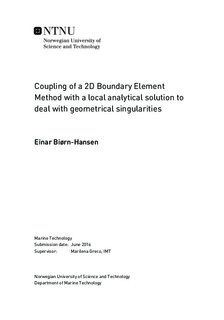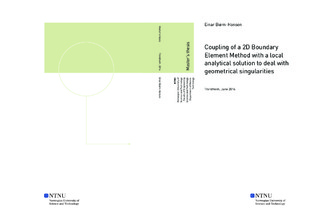| dc.description.abstract | Boundary Element Method, BEM, as a numerical tool to solve boundary values problems, has been developed and tested. The numerical scheme is coupled with known analytical flow models for geometrical singularities, and results compared. Both problems in infinite fluid, and free surface are investigated, and convergence issues addressed. Accuracy and error approximation of the solver is presented.
As an introduction, the BEM solver is applied to BVPs where analytical solutions are known. For the case of a circle, double wedge and rounded square in infinite fluid, the added mass is calculated, and good agreement with analytical solutions are found.
Later, a local flow model is introduced in the presence of geometrical singularities. Both direct and least square matching of the solutions are used. The solutions sensitivity to the local solutions parameters is investigated. In both cases it is found that a low number of constants and matching nodes on the boundary of the body, produce the best results. On a late stage in the work on this thesis, it is found that the reason for the latter, might be that the solver is biased to produce better results for boundary matching nodes, which is discussed in the thesis. Despite that a low number of constants (2), is found to give best matching, a higher number of constants is chosen for the final model. Reason being that using two constants in the local solution, gives poor matching of the velocity in the intersection between the domains. The results form both models show good agreement, and the added mass deviates with about 2\% from the "sharpest" rounded square. The order of accuracy is found to be lower than the theoretical order, and the reason for this should be investigated further. The error bands show convergence.
BVPs including the free surface are analyzed in the last part of the thesis. This is done both using "double body" considerations, and by distributing free space Green's functions over the body and free surface. For bodies with wall sided boundary conditions, both methods produce good results, tested for an oscillating half-cylinder. Analyzing the same BVP for a wedge, which is not orthogonal to the surface, convergence issues in the free surface are experienced for the latter method. On the body surface the results for both methods agree with with the analytical. Addressing the convergence issue, a local flow model is introduced in the intersection between the body and surface. This deals with the convergence issue, but results in deviating values for the velocity potential, giving to low values of the added mass. | |

